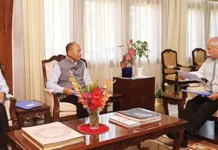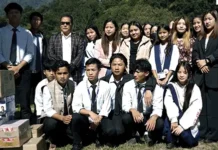[ Brig Kuldip Singh and Gen NC Vij ]
We have been in the midst of a serious face-off with China along our northern borders in eastern Ladakh since May 2020. In the Galwan valley clash on 15/16 June, 2020, our brave soldiers fought fearlessly and tenaciously to teach the Chinese a befitting lesson. Unlike in 1962, when the nation was unprepared for war, this time the Indian armed forces were far better prepared with battle-hardened soldiers, motivated officers and a determined national leadership. This made all the difference.
In 1962, unfortunately, all these factors weighed heavily against us. Despite all the shortcomings, however, there were areas where we fought valiantly and reversed the Chinese onslaught, incurring heavy casualties on them. Rezangla (Chushul sector) in eastern Ladakh and Walong in Lohit valley, are two such areas.
This story is about the Walong sector, where our battalion, the 4 Dogra, as a part of the 11 Mountain Brigade, fought a tenacious battle against the Chinese to halt the marauding offensive in the Walong sector and restore the territorial honour of the NEFA, now Arunachal Pradesh. Lieutenant (later Brigadier) Kuldip, the co-author, was then a young lieutenant who fought gallantly in the battle, and Major (later General and COAS) NC Vij joined the battalion a few days later in the wake of the Chinese war, straight from the Indian Military Academy, Dehradun.
The 11 Mountain Brigade, though hurriedly assembled to defend Walong with the 4 Sikh, 6 Kumaon and 3/3 Gorkha Rifles, had been engaged in fierce fighting with the Chinese since 20 October, 1962. By early November, the enemy had begun to induct a fresh division for their final offensive. 11 Brigade Commander, Brig Naween Rawlley ordered the 6 Kumaon to dislodge the Chinese from Yellow Pimple (12,750 ft).
On 14 November, 1962, a brave attempt by the 6 Kumaon to capture Yellow Pimple against heavy odds could not succeed and the Trijunction (13,250 ft) was in danger of falling to the Chinese. As the 4 Dogra flew into Walong by platoons and companies, Brig Rawlley ordered the CO of the 4 Dogra, commanded by Lt Col RS Pathania, to relieve the 6 Kumaon before the Chinese overran Trijunction.
Lt Col Pathania was a battle-hardened officer. Anticipating total lack of artillery support, Trijunction being out of artillery support range, he ordered the men to carry four times the normal scale of ammunition for rifles, light machine guns (LMG), 2-inch mortars and hand grenades. This meant that the Dogras at Trijunction would fight with infantry platoon weapons only, whereas the Chinese had the support of their divisional artillery. The Dogras braced themselves to fight the toughest battle of their history.
The thought uppermost in our minds was to defend the honour and sacred soil of NEFA, now Arunachal Pradesh, irrespective of the sacrifices demanded from our soldiers.
Major KJS Grewal, commanding Delta company and Col Pathania’s group, including Lt Kuldip Singh, the battalion intelligence officer, commenced their march to Trijunction on the night of 14 November, 1962. About one kilometre short of Trijunction, the Dogra column, being navigated by Lt Kuldip Singh, ran into a strong Chinese block and intense small arms fire. Undeterred and displaying conspicuous courage of exceptional order, Grewal ordered a charge through the strongly held enemy position. Kuldip Singh and two section commanders wielding LMGs, along with Grewal and his soldiers charged uphill, blasting their way through the Chinese block.
The hills echoed with the Dogras’ war cries, “Jwala Mata Ki Jai” and “Durga Mata Ki Jai.” The Chinese were stunned with the ferocity of the offensive and gave way. Kuldip, Grewal and his leading platoons surged through the opening and reached Trijunction, where Grewal took over the trenches from the CO of the 6 Kumaon, then under the command of Lt Col Madiah. These were open, shallow trenches with no overhead cover, mine fields or wire obstacles. The enemy was barely 40 yards from the crest. With such unprepared defences, the defenders had hardly any chance to retain control over the area for long against a likely determined attack by the enemy.
Grewal launched a series of assaults to push back the Chinese. In vicious hand-to-hand fight with bayonets, grenades, and machetes, the Dogras wrested back the forward trenches. This came at a considerable cost as 20 brave Dogras made the supreme sacrifice. Grewal, Kuldip and Subedar Ram Lal were wounded.
At 0730 hours on 16 November, the Chinese launched yet another massive attack under heavy artillery barrage. After one hour of fierce close quarter combat, the attack was repulsed. This, however, came at considerable cost as Grewal’s company suffered more casualties. Only 3 LMGs remained actively firing, 2-inch mortar bombs and hand grenades were exhausted; there were no sign of reinforcements. By now over 50 percent of the Dogras had made the supreme sacrifice, and most of the remainder were wounded.
At 0830 hours, Col Madiah ordered pullout from Trijunction to the Lohit river-Yapak Nallah junction, the designated check point for the brigade’s withdrawal. At Grewal’s suggestion, Col Madiah, with about 25 survivors of the 6 Kumaon, left Trijunction at 0900 hours. Kuldip was ordered to leave with 5 walking wounded soldiers at 0930 hours.
The courageous Major Grewal, with two LMG teams kept the Chinese at bay for a number of hours. Soon, another wave of the Chinese swarmed over Trijunction and overwhelmed Grewal and the LMG teams.
Thus ended at Trijunction the most heroic and bloodiest battle in the eastern sector in Walong.
Meanwhile, at firm base-Yapak ridge, Subedar Rattan Chand and his platoon of 4 Dogra held the defences. The battalion’s doctor, Lt GS Subba had established the regimental aid post there for treatment of the wounded. This position straddled the Chinese axis of advance to Lohit-Yapak Nallah junction (LYJ) where the enemy had intended to establish a block to trap the withdrawing units of the 11 Brigade.
The enemy launched their final offensive on the night of 15/16 November. By 1130 hours of the 16th, most positions in the brigade had fallen. Though ordered to abandon position, Rattan Chand and Dr Subba declined to withdraw in order to protect their commanding officer, who was still ahead of the firm base.
Three Chinese attacks were repulsed by Subedar Rattan Chand and his brave men. By 1800 hours, the enemy encircled the firm base and, after a gruesome series of close quarters combat, the position fell, but not before Subedar Rattan Chand and all his soldiers made the supreme sacrifice. The courageous doctor, Lt Subba died, treating the wounded in the medical bunker. The firm base was the last position to fall of the 11 Mountain Brigade on the night of 16/17 November.
Thanks to the extremely gallant action of Subedar Rattan Chand and his valiant soldiers, the Chinese failed to establish a block at the Lohit-Yapak junction by the 16th evening. Consequently, nearly 1,800 all ranks of 11 Mountain Brigade pulled out to safety.
In March 1963, Lt Kuldip Singh led a team to Walong to recover and cremate our fallen comrades. At the firm base, they were stunned to find the bodies of Lt Subba, Subedar Rattan Chand and 28 martyrs of the 4 Dogra still in and around the bunkers, amidst heaps of cartridge cases which told of the ferocity of the fight put up by them.
In just 36 hours of intense fighting at Trijunction and at the firm base, the 4 Dogra sacrificed hundreds of brave soldiers while defending the honour and sanctity of what is now Arunachal Pradesh’ sacred territory and inflicted far more casualties on the Chinese attackers.
Brig Rawlley acknowledged that the gritty fighting and sacrifices of the Bravo and Delta companies of the 4 Dogra on 16 November had halted the Chinese offensive in its tracks and allowed the 11 Mountain Brigade to consolidate.
The Chinese were so severely mauled that they did not dare advance beyond the Lohit-Yapak junction as our units were holding further defensive positions in the Lohit valley sector. (Brig Kuldip Singh and Gen NC Vij, both of the 4 Dogra, fought in the epic battle.)


